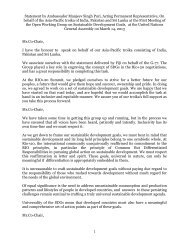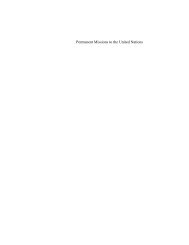STATE OF THE WORLD'S CITIES 2012/2013 Prosperity
STATE OF THE WORLD'S CITIES 2012/2013 Prosperity
STATE OF THE WORLD'S CITIES 2012/2013 Prosperity
Create successful ePaper yourself
Turn your PDF publications into a flip-book with our unique Google optimized e-Paper software.
State of the World’s Cities <strong>2012</strong>/<strong>2013</strong><br />
linkages among them.<br />
When equity Its absence will will<br />
POLICy is embedded have the reverse effect,<br />
in urban development<br />
compounding any existing<br />
strategies, efficiency is<br />
enhanced, asset utilization<br />
biases, or dysfunctions<br />
becomes optimal,<br />
already hindering<br />
productivity improves, social prosperity.<br />
cohesion is strengthened,<br />
Undoubtedly, some<br />
and both sustainability and cities have demonstrated a<br />
resilience are enhanced.<br />
capacity to stimulate growth<br />
and prosperity even in the<br />
absence of equity. However,<br />
as has become amply evident in the past three decades,<br />
such prosperity, coupled with uneven distribution, remains<br />
narrowly confined and is unsustainable. Conversely, cities<br />
that have built equity into their local development strategies<br />
are better placed for enhanced prosperity.<br />
Equity reduces alienation and exclusion, paving the<br />
way for empowerment and engagement of all social groups,<br />
and for the realization of the full potential of the entire<br />
population. Indeed, cities that have removed impediments<br />
to the full engagement of women, youths and even the<br />
Box 2.4.2<br />
Spatial divisions exacerbate inequality<br />
Spatial inequalities are not only a forerunner of social and<br />
economic divisions; these in turn cause further inequalities and<br />
different forms of exclusion and marginalization. In Jordan’s<br />
capital, for instance, 97 per cent of households in Western<br />
Amman have computers while in Eastern Amman the proportion<br />
is no more than eight per cent. Not surprisingly, in Western<br />
Amman more than 50 per cent of males and 20 per cent of<br />
females earn more than USD1,400 monthly, compared with only<br />
two per cent for males and less than one per cent for females in<br />
Eastern Amman. 7<br />
The urban divide appears to widen with higher degrees of<br />
economic prosperity; at least this is the perception of populations<br />
and local experts. In Bangalore, where specialisation in computer<br />
technologies has brought a fair amount of economic prosperity,<br />
a local expert remarked that “while quality of life is comfortable<br />
for ‘elite Bangalore’, it is not so for the ‘other Bangalore’ which<br />
comprises the majority of the population”. 8 In São Paulo, even<br />
as municipal authorities strive to integrate favelas, informal<br />
settlements and rehabilitated urban neighbourhoods into a more<br />
inclusive city, wealthy Paulistanos resist the process and gravitate<br />
to more exclusive enclaves. The result is what has been dubbed<br />
a ‘city of walls’ where any visible prosperity appears to be largely<br />
monopolised by the wealthy. In Lusaka, a local expert reports<br />
70<br />
elderly have invariably enhanced overall prosperity.<br />
Equity is not simply a normative concern, related to<br />
issues of fairness and justice, important as these may be. It is<br />
a material factor which directly impinges on the process of<br />
social and material sustenance. In fact, through removal of<br />
‘unfreedoms’, and with the attendant broadening of choices<br />
and opportunities, equity enhances the city’s transformative<br />
capacity while also promoting identity and agency among<br />
the population.<br />
The social process that comes with the opportunities<br />
made available to all through public goods like quality<br />
education and skills, enables the population to remain<br />
engaged and to stake a claim on the city. In this respect, the<br />
way a city shapes, and is in turn shaped by, its population,<br />
will largely depend on whether urban systems provide all<br />
residents with equal opportunities for development and the<br />
ability to exert agency.<br />
Inequity is inefficient from an economic perspective. As<br />
stressed by Sen, “the primitiveness of social developments<br />
(such as widespread illiteracy, malnutrition, lack of health<br />
facilities and medical networks) is a barrier to the full<br />
realisation of the benefits of participatory growth and<br />
that ”increasing degrees of exclusion are reappearing in the<br />
city, especially with the new infrastructure under development.<br />
Segregation along racial lines is re-emerging.” 9 In Dubai, as in<br />
some other Gulf cities, the gap between nationals and nonnationals<br />
(access to schooling, public hospitals, health insurance,<br />
adequate and affordable housing, labour grievances and rights) is<br />
unequal in the extreme.<br />
Research shows that when combined, the physical and social<br />
divisions between rich and poor neighbourhoods can generate<br />
further exclusion and marginalization, especially when the<br />
poor are confined to farther neighbourhoods with inadequate<br />
accessibility. The underprivileged people living in these ‘lost’<br />
areas suffer from a triple jeopardy: long distances, high transport<br />
costs and excessive commuting times. This turns into a genuine<br />
“spatial poverty trap” that conspires against shared prosperity<br />
through restrictions on jobs, compounding gender differences,<br />
limiting social interactions and reducing social capital, increasing<br />
the likelihood of crime and violence, with worsening living<br />
standards as a result. 10 The spatial inequalities so visible in<br />
so many cities are also the outcome of broader and deeply<br />
entrenched processes of unplanned urban development, poor<br />
governance and institutionalized exclusion and marginalisation of<br />
specific groups.


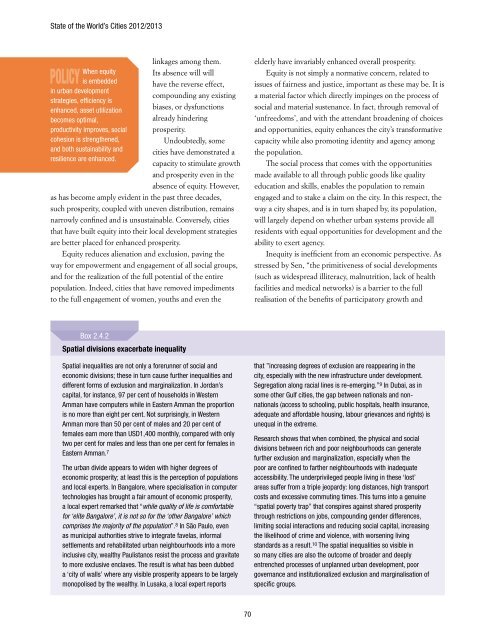

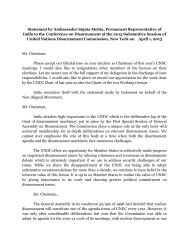
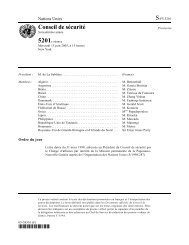
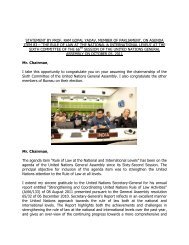
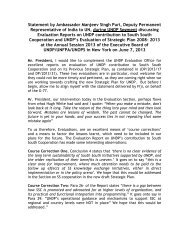
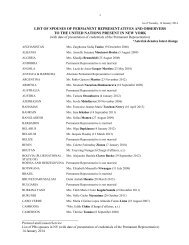
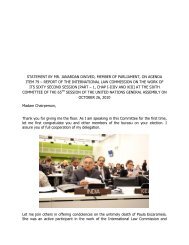
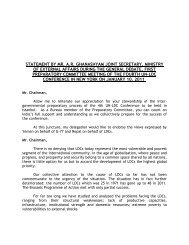
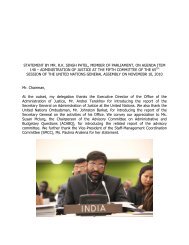

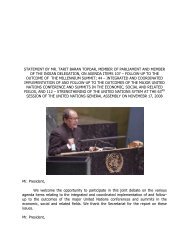
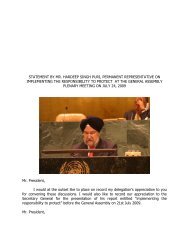
![1 statement by dr.[mrs] kakoli ghosh dastidar - Member States Portal](https://img.yumpu.com/27526598/1/190x245/1-statement-by-drmrs-kakoli-ghosh-dastidar-member-states-portal.jpg?quality=85)
